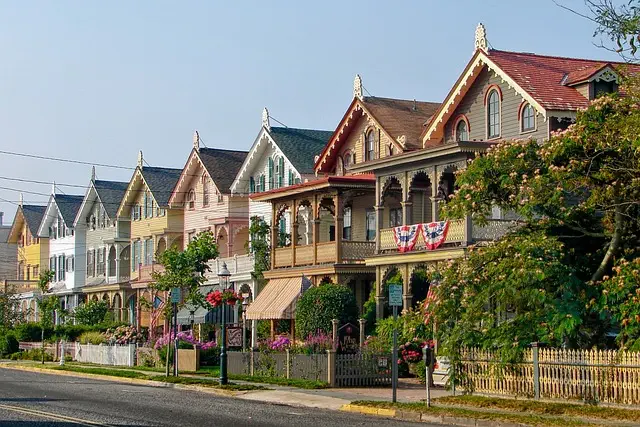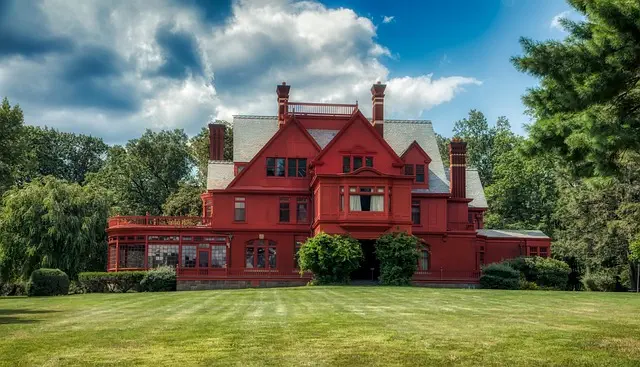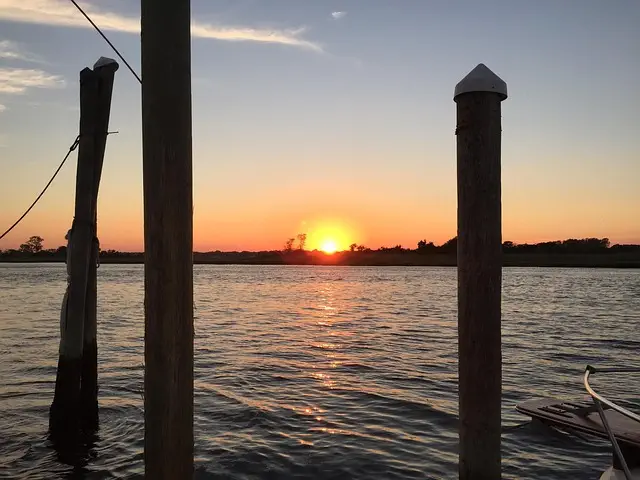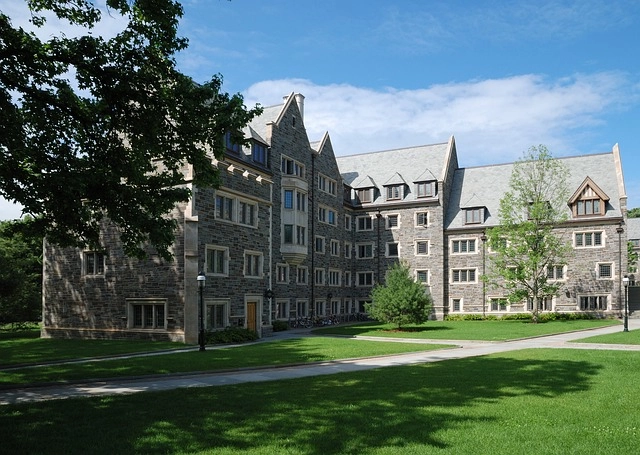The Cape May Lighthouse in Cape May Point, New Jersey, is a historical beacon erected in 1859 that has played a crucial role in maritime safety for over a century and a half. This iconic lighthouse, standing at 157 feet with its black and white stripes, has been instrumental in guiding mariners away from the treacherous shoals near the New Jersey coastline. As a key historical site within Cape May County, it offers visitors panoramic views of both the Atlantic Ocean and Delaware Bay, alongside educational insights into its past role in navigation and the rich maritime heritage of the region. The lighthouse's preservation is a testament to the importance of cultural and historical conservation, and it remains a significant attraction for those fascinated by history, nature, and the area's ecological significance. Cape May County New Jersey takes pride in this landmark, which continues to be an essential part of the local community and a draw for international tourists. The Mid-Atlantic Center for the Arts & Humanities (MAC) and the New Jersey Division of Parks and Forestry are integral to maintaining the lighthouse's historical integrity and ensuring it remains a living testament to our shared heritage.
Discover the storied history and enduring allure of the Cape May Lighthouse, a majestic sentinel standing watch over Cape May Point in New Jersey. This article delves into the lighthouse’s pivotal role in maritime navigation, its architectural significance, and the rich biodiversity that thrives around it within Cape May County. Explore the preservation efforts that ensure this landmark remains a beacon for generations to come. From climbing its spiraling stairs to enjoying seasonal activities at Cape May Point State Park, there’s a unique experience for every visitor. Join us as we ascend the layers of history and uncover the tales encased within this iconic structure.
- Unveiling the Iconic Cape May Lighthouse: A Beacon of History
- Architectural Marvel: The Design and Construction of the Cape May Lighthouse
- Navigating the Seas: The Role of the Lighthouse in Maritime Safety
- The Environmental Ecosystem: Cape May Point's Biodiversity and the Lighthouse's Surroundings
- A Journey Up High: Visitor Experiences and Climbing the Lighthouse
- Preservation Efforts: Restoring and Maintaining the Legacy of the Cape May Lighthouse
Unveiling the Iconic Cape May Lighthouse: A Beacon of History

The iconic Cape May Lighthouse stands as a testament to maritime navigation and the rich history of Cape May Point in New Jersey. Erected in 1859, this majestic structure, also known as the Old Light, is situated within the bounds of Cape May County and has been guiding sailors safely to shore for nearly two centuries. Its construction was a response to the need for a more visible aid to maritime navigation due to the treacherous shoals that lie off its coast. Today, it remains one of the most recognized landmarks in the region, offering visitors panoramic views of both the Delaware Bay and the Atlantic Ocean. The lighthouse’s striking design, with its red and white striped exterior and black capstone, is not only eye-catching but also functional, making it a vital tool for modern mariners as well. A climb to the top rewards adventurers with breathtaking vistas and an opportunity to walk through history. The lighthouse keeper’s quarters have been preserved and transformed into an educational experience for tourists, providing insight into the lives of those who maintained this crucial beacon. Cape May County, New Jersey, is enriched by this enduring symbol that continues to draw history enthusiasts, nature lovers, and casual travelers alike, all eager to witness the grandeur and significance of the Cape May Lighthouse.
Architectural Marvel: The Design and Construction of the Cape May Lighthouse

Standing as a beacon on the southeasternmost tip of Cape May Point in New Jersey, the Cape May Lighthouse is an architectural marvel that has guided mariners safely past the treacherous waters off the coast since its completion in 1859. Designed by a team of engineers led by Uziel Sherwood and constructed primarily with brick and hand-hewn wood, this lighthouse is a testament to the craftsmanship and ingenuity of the 19th century. It towers at an impressive height of 157 feet, with its black and white spiral stripes visible for miles across Cape May County, New Jersey. The structure’s conical shape, tapering towards the top, was not only aesthetically pleasing but also practical, ensuring that its light would be seen from as far away as possible. The lighthouse features a double-helix staircase with 218 steps, allowing keepers to ascend to the lantern room without their footsteps disturbing the light’s sensitive mechanisms. The Cape May Lighthouse, an iconic landmark of Cape May County, New Jersey, remains a symbol of historical preservation and a must-visit for tourists seeking a glimpse into the past while appreciating the panoramic views it offers of the surrounding area. Its enduring presence continues to be a vital part of the region’s identity and heritage, drawing visitors from near and far to admire its design, construction, and the critical role it has played in maritime safety over the years.
Navigating the Seas: The Role of the Lighthouse in Maritime Safety

Throughout its storied history, the Cape May Lighthouse, standing with steadfast vigilance on Cape May Point in New Jersey, has played a pivotal role in maritime safety within the waters of Cape May County. Its towering structure, painted in the iconic red and white stripes, has served as a beacon for seafarers navigating the treacherous shoals and shifting sands off the New Jersey coastline. Constructed in 1859, this historic lighthouse stands as a testament to human ingenuity in aiding navigation, reducing the likelihood of shipwrecks, and saving countless lives. The light it emits is a vital tool for mariners, providing essential guidance to ensure safe passage through the busy shipping lanes and sensitive marine environments that characterize Cape May County’s coastal waters. Today, this historic site not only continues its original mission but also educates visitors on its significance in the realm of maritime navigation and the rich history of the area it protects.
The Environmental Ecosystem: Cape May Point's Biodiversity and the Lighthouse's Surroundings

Cape May Point, situated within Cape May County, New Jersey, is a region of remarkable biodiversity, with its ecosystems showcasing an array of plant and animal species. The lighthouse standing sentinel at this tip of land not only serves as a historic beacon but also forms part of the unique environment that attracts avian migrants from across the globe. These migratory birds utilize the area for nesting, feeding, and resting, contributing to the rich tapestry of life found here. The nearby marshes, wetlands, and coastal waters offer habitat for a multitude of species, including rare and endangered varieties. This biodiversity is a testament to the conservation efforts in the region, which aim to preserve the natural heritage and ecological balance of Cape May Point.
The surroundings of the Cape May Lighthouse are a crucial component of the area’s environmental ecosystem. The lighthouse, built in 1859, has stood as a witness to the dynamic changes of this coastal environment. Its location on the southernmost point of New Jersey provides an excellent vantage point for both maritime navigation and wildlife observation. The nearby Delaware Bay and Atlantic Ocean influence the climate and conditions of the region, shaping its flora and fauna in unique ways. The Cape May County area is particularly known for its fall migration, when the skies are filled with birds making their seasonal journey, offering visitors a natural spectacle unlike any other.
A Journey Up High: Visitor Experiences and Climbing the Lighthouse

Within Cape May County, New Jersey, the iconic Cape May Lighthouse stands as a beacon, both historically and literally, offering visitors a unique experience that blends the past with an exhilarating climb to panoramic views. As travelers ascend the 199 steps of this grand structure, they embark on a journey that transports them back in time while rewarding them with breathtaking vistas of the Atlantic coastline and the Delaware Bay. The lighthouse, an enduring landmark since its completion in 1859, has been meticulously preserved to provide a safe and engaging climb for all ages. Each step taken is a step into the maritime history of New Jersey, where the lighthouse has played a crucial role in guiding ships away from treacherous shoals and sandbars. Today, it stands as a testament to the ingenuity of 19th-century engineering and offers an unparalleled opportunity for sightseers to witness the beauty of Cape May Point from its highest point. The experience is not only a climb but an immersion into the rich heritage of Cape May County, New Jersey, making it a must-visit destination for both history enthusiasts and nature lovers alike.
Preservation Efforts: Restoring and Maintaining the Legacy of the Cape May Lighthouse

The Cape May Lighthouse, a storied beacon standing sentinel over the confluence of the Delaware Bay and the Atlantic Ocean in Cape May Point, New Jersey, has been guiding mariners safely to shore for nearly two centuries. As part of Cape May County’s rich maritime heritage, this iconic structure is not just a navigational aid but also a testament to the area’s history. Preservation efforts for the lighthouse have been ongoing since its decommissioning as an active aid to navigation in 1933. Today, these efforts are spearheaded by the Mid-Atlantic Center for the Arts & Humanities (MAC) and the New Jersey Division of Parks and Forestry. Through meticulous restoration and diligent maintenance, these organizations work to preserve the lighthouse’s structural integrity and historical significance for future generations. The commitment to restoring the lighthouse includes repairing stonework, repainting its distinctive red-and-white stripes, and ensuring that its internal mechanisms function correctly. This dedication to upkeep not only honors Cape May County New Jersey’s storied past but also guarantees that this national landmark remains a vibrant part of the local community and a destination for visitors from across the globe, eager to climb its 199 steps and take in the breathtaking panoramic views. These preservation initiatives underscore the importance of maintaining historical sites as living monuments to our collective heritage.



